run flat FORD TRANSIT CONNECT 2020 Owners Manual
[x] Cancel search | Manufacturer: FORD, Model Year: 2020, Model line: TRANSIT CONNECT, Model: FORD TRANSIT CONNECT 2020Pages: 509, PDF Size: 7.73 MB
Page 141 of 509
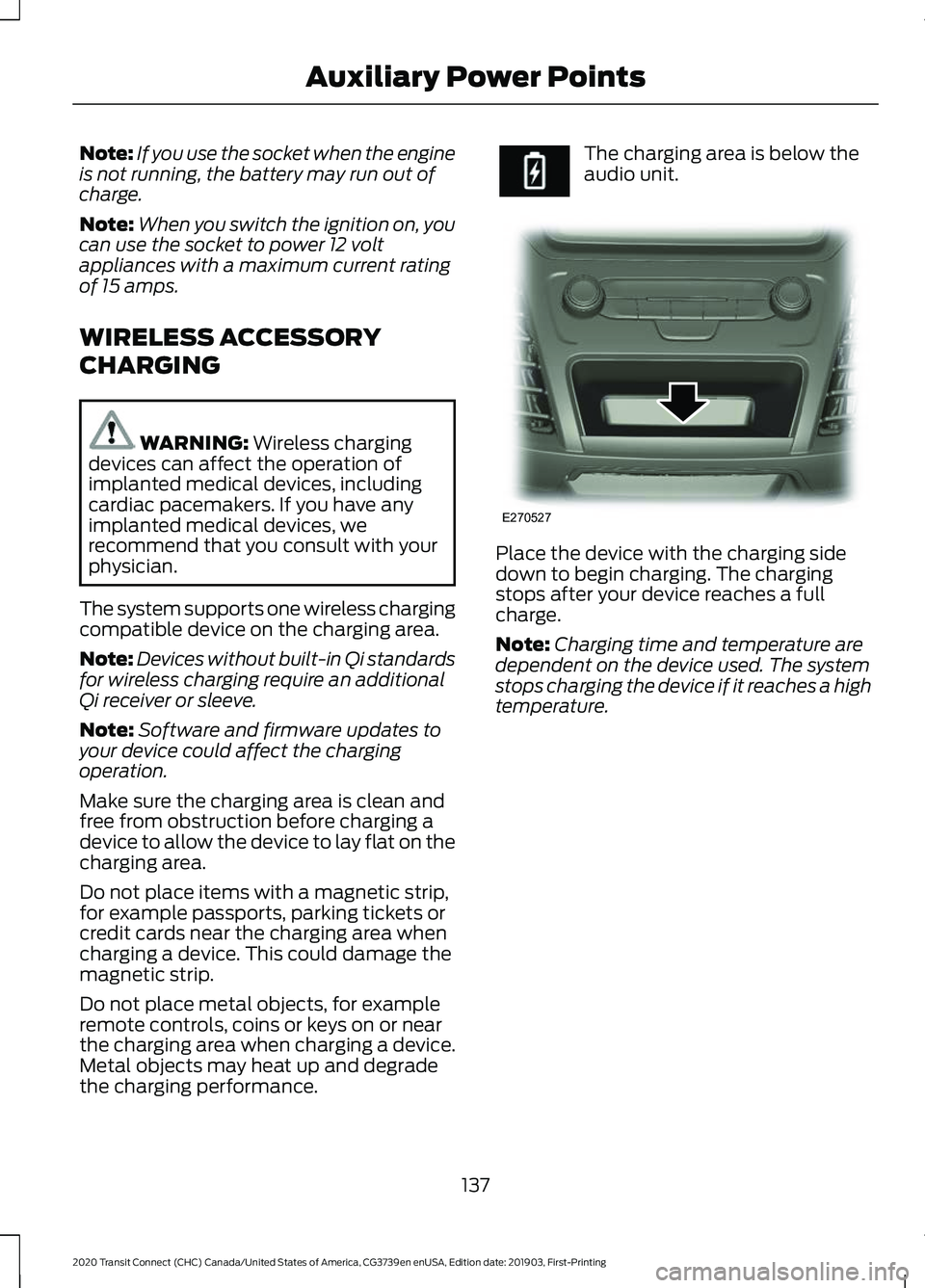
Note:
If you use the socket when the engine
is not running, the battery may run out of
charge.
Note: When you switch the ignition on, you
can use the socket to power 12 volt
appliances with a maximum current rating
of 15 amps.
WIRELESS ACCESSORY
CHARGING WARNING: Wireless charging
devices can affect the operation of
implanted medical devices, including
cardiac pacemakers. If you have any
implanted medical devices, we
recommend that you consult with your
physician.
The system supports one wireless charging
compatible device on the charging area.
Note: Devices without built-in Qi standards
for wireless charging require an additional
Qi receiver or sleeve.
Note: Software and firmware updates to
your device could affect the charging
operation.
Make sure the charging area is clean and
free from obstruction before charging a
device to allow the device to lay flat on the
charging area.
Do not place items with a magnetic strip,
for example passports, parking tickets or
credit cards near the charging area when
charging a device. This could damage the
magnetic strip.
Do not place metal objects, for example
remote controls, coins or keys on or near
the charging area when charging a device.
Metal objects may heat up and degrade
the charging performance. The charging area is below the
audio unit.
Place the device with the charging side
down to begin charging. The charging
stops after your device reaches a full
charge.
Note:
Charging time and temperature are
dependent on the device used. The system
stops charging the device if it reaches a high
temperature.
137
2020 Transit Connect (CHC) Canada/United States of America, CG3739en enUSA, Edition date: 201903, First-Printing Auxiliary Power Points E270527
Page 168 of 509
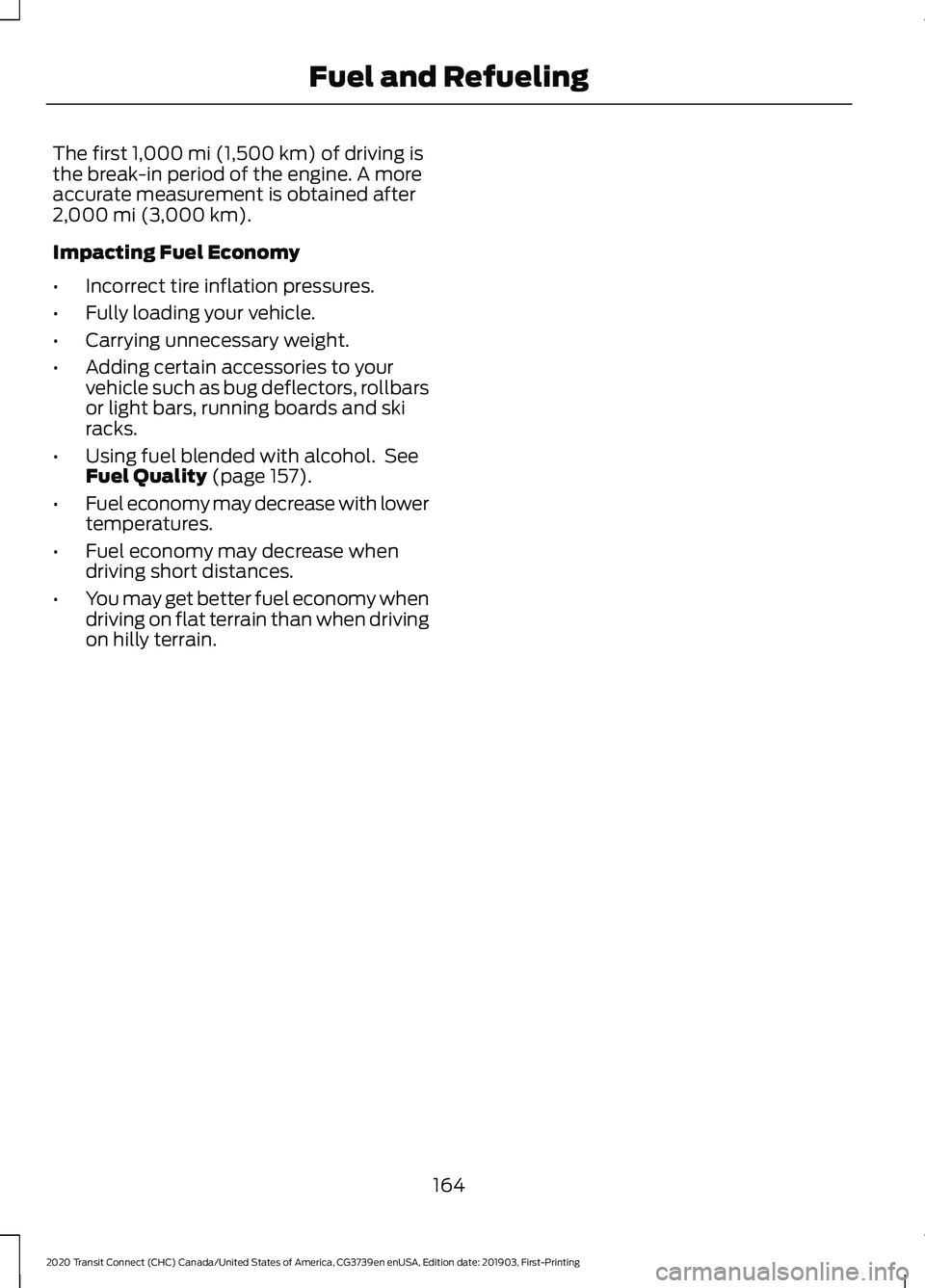
The first 1,000 mi (1,500 km) of driving is
the break-in period of the engine. A more
accurate measurement is obtained after
2,000 mi (3,000 km)
.
Impacting Fuel Economy
• Incorrect tire inflation pressures.
• Fully loading your vehicle.
• Carrying unnecessary weight.
• Adding certain accessories to your
vehicle such as bug deflectors, rollbars
or light bars, running boards and ski
racks.
• Using fuel blended with alcohol. See
Fuel Quality
(page 157).
• Fuel economy may decrease with lower
temperatures.
• Fuel economy may decrease when
driving short distances.
• You may get better fuel economy when
driving on flat terrain than when driving
on hilly terrain.
164
2020 Transit Connect (CHC) Canada/United States of America, CG3739en enUSA, Edition date: 201903, First-Printing Fuel and Refueling
Page 251 of 509
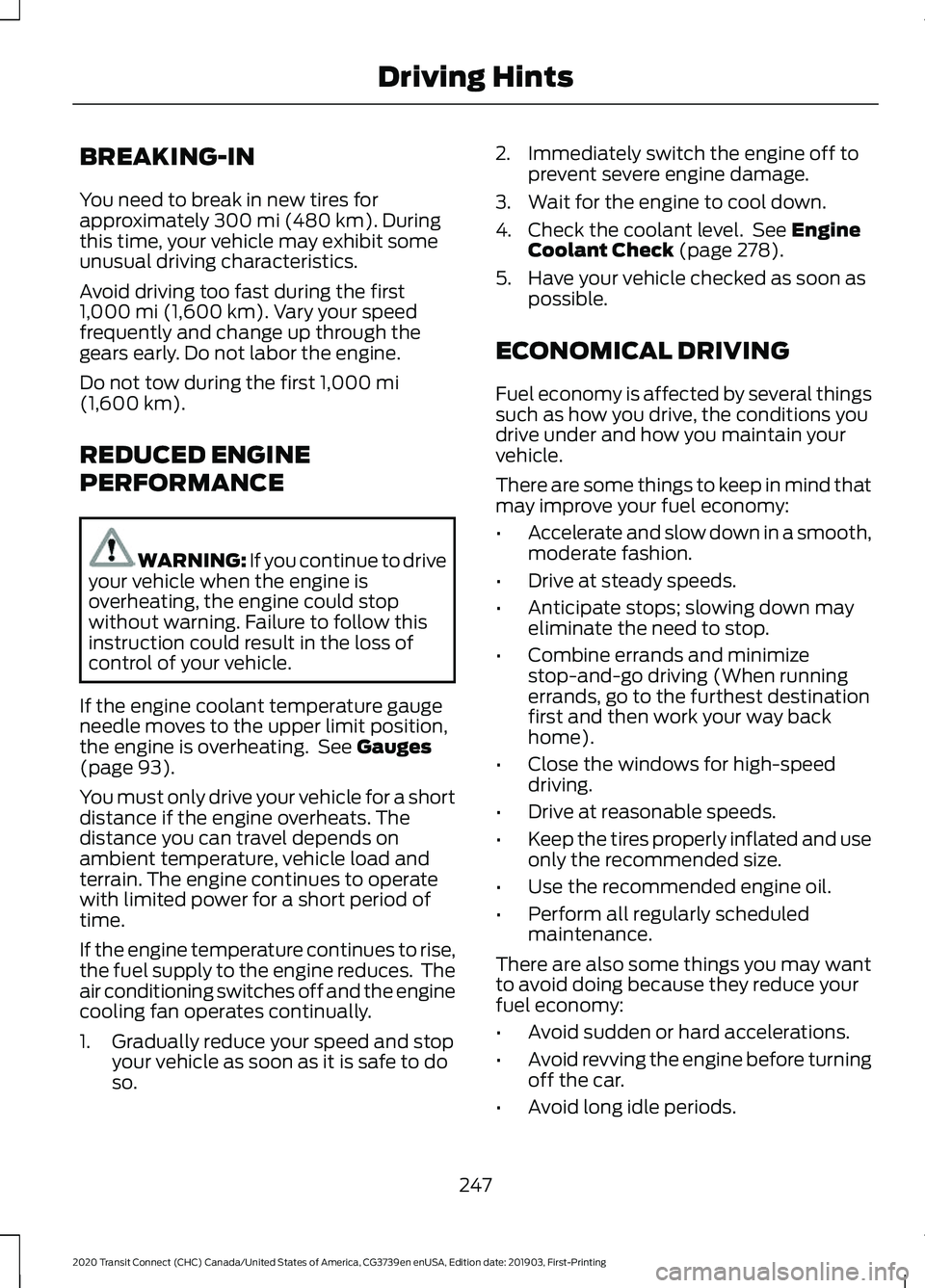
BREAKING-IN
You need to break in new tires for
approximately 300 mi (480 km). During
this time, your vehicle may exhibit some
unusual driving characteristics.
Avoid driving too fast during the first
1,000 mi (1,600 km)
. Vary your speed
frequently and change up through the
gears early. Do not labor the engine.
Do not tow during the first
1,000 mi
(1,600 km).
REDUCED ENGINE
PERFORMANCE WARNING: If you continue to drive
your vehicle when the engine is
overheating, the engine could stop
without warning. Failure to follow this
instruction could result in the loss of
control of your vehicle.
If the engine coolant temperature gauge
needle moves to the upper limit position,
the engine is overheating. See
Gauges
(page 93).
You must only drive your vehicle for a short
distance if the engine overheats. The
distance you can travel depends on
ambient temperature, vehicle load and
terrain. The engine continues to operate
with limited power for a short period of
time.
If the engine temperature continues to rise,
the fuel supply to the engine reduces. The
air conditioning switches off and the engine
cooling fan operates continually.
1. Gradually reduce your speed and stop your vehicle as soon as it is safe to do
so. 2. Immediately switch the engine off to
prevent severe engine damage.
3. Wait for the engine to cool down.
4. Check the coolant level. See
Engine
Coolant Check (page 278).
5. Have your vehicle checked as soon as possible.
ECONOMICAL DRIVING
Fuel economy is affected by several things
such as how you drive, the conditions you
drive under and how you maintain your
vehicle.
There are some things to keep in mind that
may improve your fuel economy:
• Accelerate and slow down in a smooth,
moderate fashion.
• Drive at steady speeds.
• Anticipate stops; slowing down may
eliminate the need to stop.
• Combine errands and minimize
stop-and-go driving (When running
errands, go to the furthest destination
first and then work your way back
home).
• Close the windows for high-speed
driving.
• Drive at reasonable speeds.
• Keep the tires properly inflated and use
only the recommended size.
• Use the recommended engine oil.
• Perform all regularly scheduled
maintenance.
There are also some things you may want
to avoid doing because they reduce your
fuel economy:
• Avoid sudden or hard accelerations.
• Avoid revving the engine before turning
off the car.
• Avoid long idle periods.
247
2020 Transit Connect (CHC) Canada/United States of America, CG3739en enUSA, Edition date: 201903, First-Printing Driving Hints
Page 310 of 509

•
Higher - to allow higher load carrying
capacity and to allow it to travel over
rough terrain without getting hung up
or damaging underbody components.
• Shorter - to give it the capability to
approach inclines and drive over the
crest of a hill without getting hung up
or damaging underbody components.
All other things held equal, a shorter
wheelbase may make your vehicle
quicker to respond to steering inputs
than a vehicle with a longer wheelbase.
• Narrower - to provide greater
maneuverability in tight spaces,
particularly in off-road use. As a result of the above dimensional
differences, sport-utility vehicles, vans and
trucks often will have a higher center of
gravity and a greater difference in center
of gravity between the loaded and
unloaded condition.
These differences that make your vehicle
so versatile also make it handle differently
than an ordinary passenger car. TIRE SEALANT AND INFLATOR
KIT WARNING: Do not use the inflator
kit on run flat tires. This could cause loss
of vehicle control. WARNING: Depending on the type
and extent of tire damage, some tires
can only be partially sealed or not sealed
at all. Loss of tire pressure can affect
vehicle handling, leading to loss of
vehicle control. WARNING:
Do not use the kit on
a previously damaged tire, for example
when it has been driven under inflated.
This could cause loss of vehicle control,
personal injury or death.
If your vehicle does not have a spare wheel
it has a tire sealant and inflator kit. The kit
is in the left-hand side of the luggage
compartment. Only use the kit supplied
with your vehicle.
Note: The kit can only temporarily repair
one tire puncture with a maximum puncture
size of up to
0.24 in (6 mm).
306
2020 Transit Connect (CHC) Canada/United States of America, CG3739en enUSA, Edition date: 201903, First-Printing Wheels and TiresE166373
Page 327 of 509
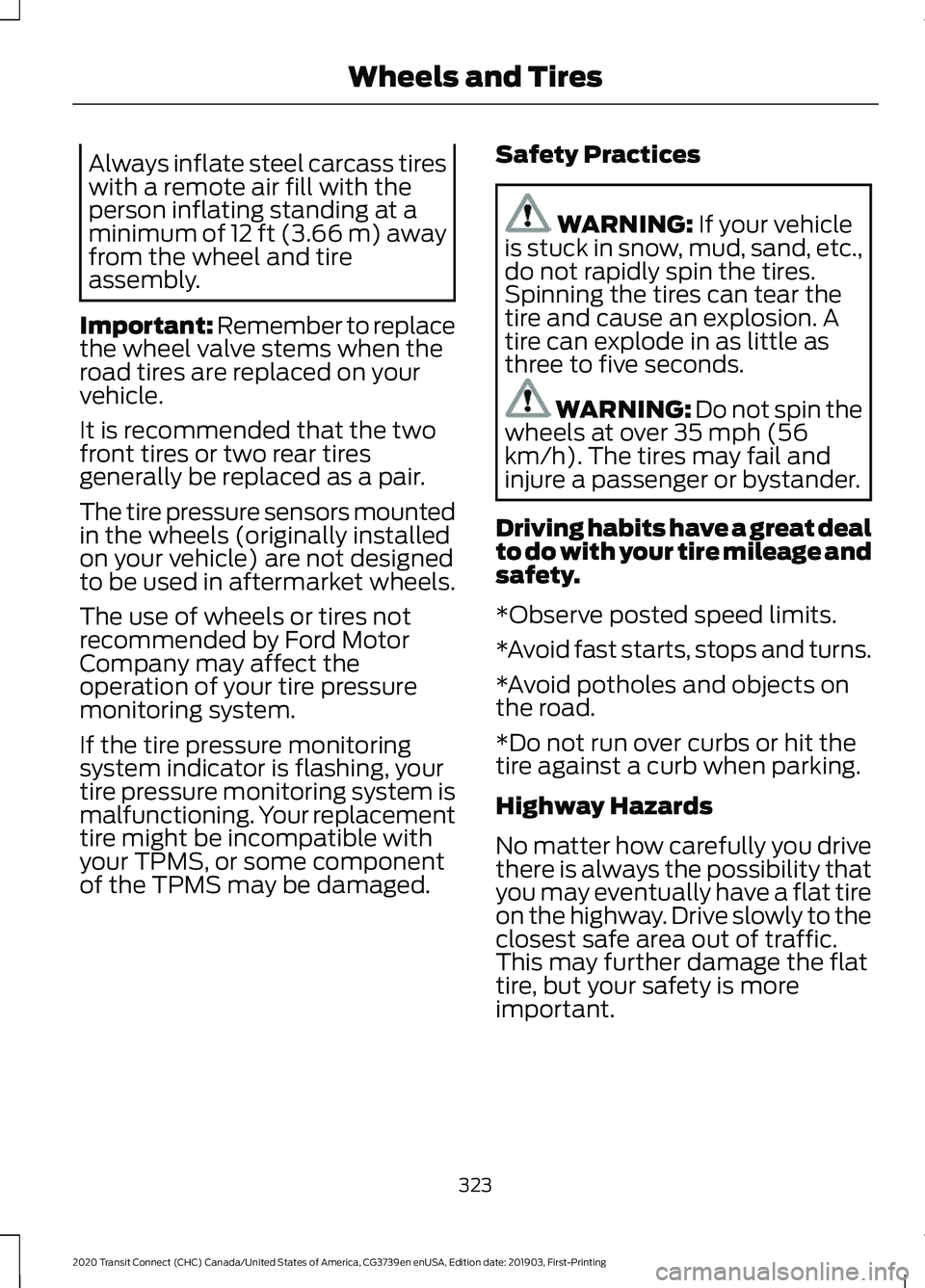
Always inflate steel carcass tires
with a remote air fill with the
person inflating standing at a
minimum of 12 ft (3.66 m) away
from the wheel and tire
assembly.
Important: Remember to replace
the wheel valve stems when the
road tires are replaced on your
vehicle.
It is recommended that the two
front tires or two rear tires
generally be replaced as a pair.
The tire pressure sensors mounted
in the wheels (originally installed
on your vehicle) are not designed
to be used in aftermarket wheels.
The use of wheels or tires not
recommended by Ford Motor
Company may affect the
operation of your tire pressure
monitoring system.
If the tire pressure monitoring
system indicator is flashing, your
tire pressure monitoring system is
malfunctioning. Your replacement
tire might be incompatible with
your TPMS, or some component
of the TPMS may be damaged. Safety Practices WARNING: If your vehicle
is stuck in snow, mud, sand, etc.,
do not rapidly spin the tires.
Spinning the tires can tear the
tire and cause an explosion. A
tire can explode in as little as
three to five seconds. WARNING: Do not spin the
wheels at over 35 mph (56
km/h). The tires may fail and
injure a passenger or bystander.
Driving habits have a great deal
to do with your tire mileage and
safety.
*Observe posted speed limits.
*Avoid fast starts, stops and turns.
*Avoid potholes and objects on
the road.
*Do not run over curbs or hit the
tire against a curb when parking.
Highway Hazards
No matter how carefully you drive
there is always the possibility that
you may eventually have a flat tire
on the highway. Drive slowly to the
closest safe area out of traffic.
This may further damage the flat
tire, but your safety is more
important.
323
2020 Transit Connect (CHC) Canada/United States of America, CG3739en enUSA, Edition date: 201903, First-Printing Wheels and Tires
Page 497 of 509
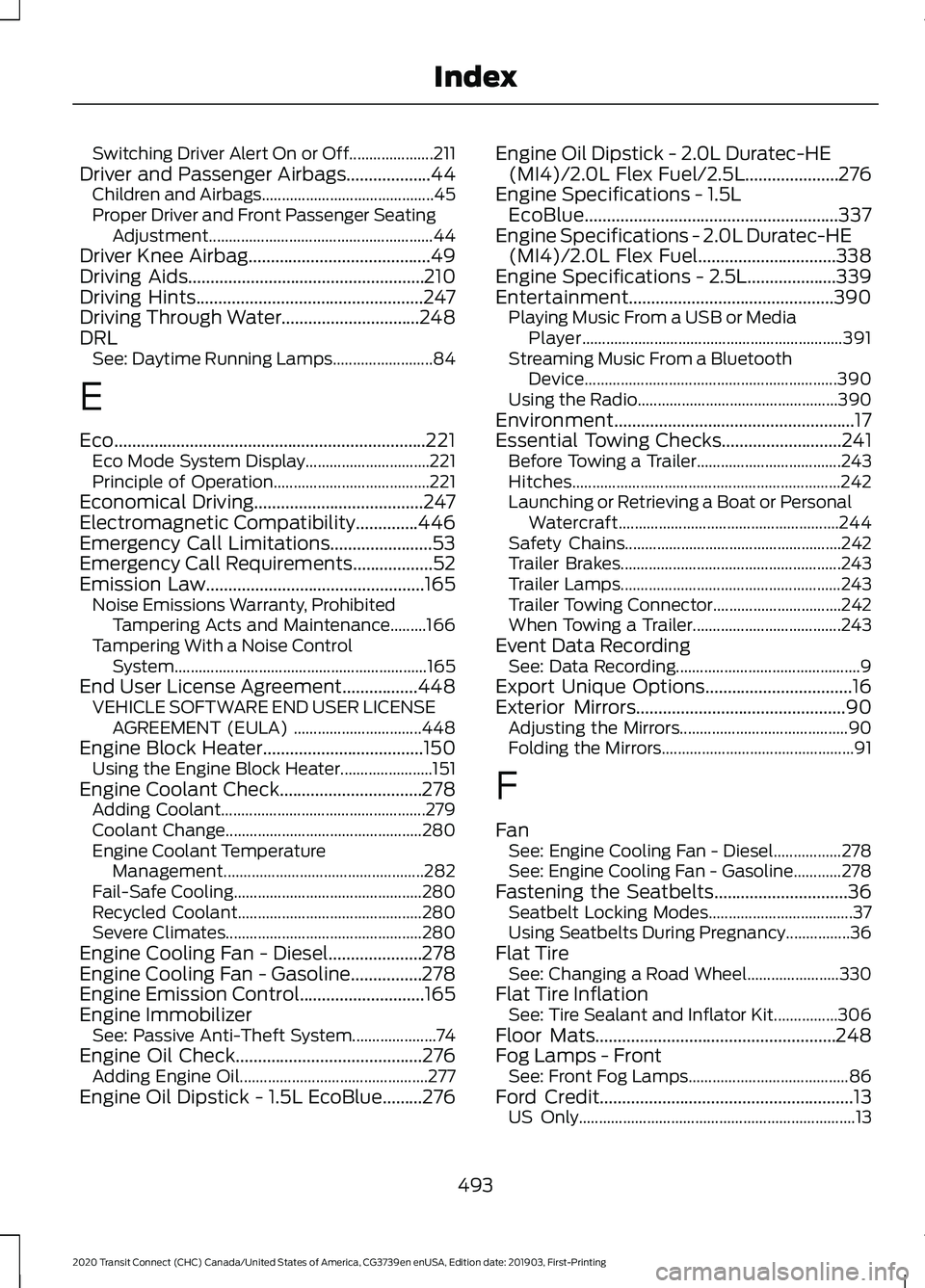
Switching Driver Alert On or Off.....................
211
Driver and Passenger Airbags...................44 Children and Airbags...........................................45
Proper Driver and Front Passenger Seating
Adjustment........................................................ 44
Driver Knee Airbag.........................................49
Driving Aids.....................................................210
Driving Hints...................................................247
Driving Through Water...............................248
DRL See: Daytime Running Lamps......................... 84
E
Eco......................................................................221 Eco Mode System Display............................... 221
Principle of Operation....................................... 221
Economical Driving
......................................247
Electromagnetic Compatibility..............446
Emergency Call Limitations.......................53
Emergency Call Requirements..................52
Emission Law
.................................................165
Noise Emissions Warranty, Prohibited
Tampering Acts and Maintenance.........166
Tampering With a Noise Control System............................................................... 165
End User License Agreement.................448 VEHICLE SOFTWARE END USER LICENSE
AGREEMENT (EULA) ................................ 448
Engine Block Heater....................................150 Using the Engine Block Heater....................... 151
Engine Coolant Check................................278 Adding Coolant................................................... 279
Coolant Change................................................. 280
Engine Coolant Temperature Management.................................................. 282
Fail-Safe Cooling............................................... 280
Recycled Coolant.............................................. 280
Severe Climates................................................. 280
Engine Cooling Fan - Diesel.....................278
Engine Cooling Fan - Gasoline................278
Engine Emission Control............................165
Engine Immobilizer See: Passive Anti-Theft System..................... 74
Engine Oil Check..........................................276 Adding Engine Oil............................................... 277
Engine Oil Dipstick - 1.5L EcoBlue.........276 Engine Oil Dipstick - 2.0L Duratec-HE
(MI4)/2.0L Flex Fuel/2.5L.....................276
Engine Specifications - 1.5L EcoBlue.........................................................337
Engine Specifications - 2.0L Duratec-HE (MI4)/2.0L Flex Fuel...............................338
Engine Specifications - 2.5L....................339
Entertainment..............................................390 Playing Music From a USB or Media
Player................................................................. 391
Streaming Music From a Bluetooth Device............................................................... 390
Using the Radio.................................................. 390
Environment......................................................17
Essential Towing Checks...........................241 Before Towing a Trailer.................................... 243
Hitches................................................................... 242
Launching or Retrieving a Boat or Personal Watercraft....................................................... 244
Safety Chains...................................................... 242
Trailer Brakes....................................................... 243
Trailer Lamps....................................................... 243
Trailer Towing Connector................................ 242
When Towing a Trailer..................................... 243
Event Data Recording See: Data Recording.............................................. 9
Export Unique Options
.................................16
Exterior Mirrors...............................................90 Adjusting the Mirrors.......................................... 90
Folding the Mirrors................................................ 91
F
Fan See: Engine Cooling Fan - Diesel.................278
See: Engine Cooling Fan - Gasoline............278
Fastening the Seatbelts..............................36 Seatbelt Locking Modes.................................... 37
Using Seatbelts During Pregnancy................36
Flat Tire See: Changing a Road Wheel....................... 330
Flat Tire Inflation See: Tire Sealant and Inflator Kit................306
Floor Mats......................................................248
Fog Lamps - Front See: Front Fog Lamps........................................ 86
Ford Credit
.........................................................13
US Only..................................................................... 13
493
2020 Transit Connect (CHC) Canada/United States of America, CG3739en enUSA, Edition date: 201903, First-Printing Index